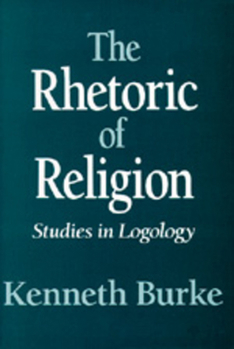The Rhetoric of Religion
Select Format
Select Condition 
Book Overview
"But the point of Burke's work, and the significance of his achievement, is not that he points out that religion and language affect each other, for this has been said before, but that he proceeds to... This description may be from another edition of this product.
Format:Paperback
Language:English
ISBN:0520016106
ISBN13:9780520016101
Release Date:April 1970
Publisher:University of California Press
Length:327 Pages
Weight:0.85 lbs.
Dimensions:0.8" x 5.5" x 8.5"
Customer Reviews
2 ratings
Religious discourse has a deep inner spiritual strength
Published by Thriftbooks.com User , 19 years ago
Kenneth Burke is one great mind of the 20th century. In this book he studies religion, particularly Saint Augustine's writings and Confessions. Through this particular study he reveals his method that is one great tool indeed. He considers language to be made of signifying elements that are the association of a certain object (sounds or letters) and a meaning. Those elements are brought together through morphology or syntax to build compound words or sentences. But Kenneth Burke goes further than Saussure and considers the signifying elements that are repeated in a text and how they are positioned in relation with one another. It is from these networks of signifying elements that he derives the deeper meaning of a text. The relations can be built along lines of similarity or difference, or even opposition. The networked elements can be similar as for their sounds or letters, though different as for their morphological or syntactic environments, or actually opposed morphologically or syntactically, or simply semantically. This is extremely complex and rich and it leads to very powerful remarks. The second step is in line with the first. No individual element, sentence, image, simile, or any other linguistic entity has a meanig all by itself. The real meaning comes from the networks in which it is positioned and how it is positioned in this network. The third step is that the stating of any signifying element implies the possible stating of its antagon. Order implies disorder, time timelessness, etc. The creation of perfection implies imperfection and God states a thou-shalt-not which implies disobedience, doing what is not supposed to be done. This is fundamental. A society does not forbid something that does not exist. If a law says we must not do something it is because it is actually performed. If a society does not forbid something it can be because it does not exist at all or because it is perfectly seen as acceptable. The absence of a law does not imply anything one way or the other. The existence of a law implies that what it forbids exists and what it authorizes exists too, as well as, in both cases, what it does not forbid or what it does not allow. Kenneth Burke injects this approach into his linguistic reading of religious texts. This is extremely powerful and you have to read the book to see how he exploits such principles. From Genesis Kenneth Burke finds out time was created by God as his first creative act, hence it implies that God's eternity before creation was timeless and that God's eternity after the end will be timeless. Eternity is not the flow of time without a beginning nor an end, but eternity is the absolute absence of both flowing and time, hence eternity is a certain static present that fills in the whole conceivable expanse of duration. Time in this conception is only contained within the alpha of the beginning and the omega of the end. If we consider the Fall, it is the result of the thou-shalt-not that implies tempta
A couple of detailed case studies of human motives
Published by Thriftbooks.com User , 24 years ago
"The Rhetoric of Religion" is the unofficial third volume in Burke's second trilogy (a claim also made by some for "Language As Symbolic Action"), following his "Rhetoric" and "Grammar of Motives," although it is clearly neither the summation nor the completion of his line of inquiry begun in those other volumes. What makes this volume stand out is more the applied use of his concepts than their theoretical development. Burke offers a short discussion on "On Words and The Word" before proceeding to a detailed analysis of verbal action in St. Augustine's "Confessions." For me the key section is his analysis of the first three chapters of Genesis, where he works backwards to explain the creation of the Creation story, the best explication of Burke's Iron Law of History. Returning to his literary roots, the final section finds Burke offering a conversation between God and Satan in "Prologue in Heaven," where Burke literally puts his case before the highest court. Ultimately, the point is one that Burke has sounded before: that we should not be using terminologies developed in laboratories for our study of human motives. Instead, Burke offers his theories of transcendence and the model of the symbolic act as developed over the previous four decades. Consequently, "The Rhetoric of Religion" is not a book with which to begin your inquiry into either Burke or the field of rhetoric and social theory, but rather the volume that provides a more practical application of his work. Like "Language As Symbolic Action," it should be read after going through his "Rhetoric" and "Grammar" volumes.






